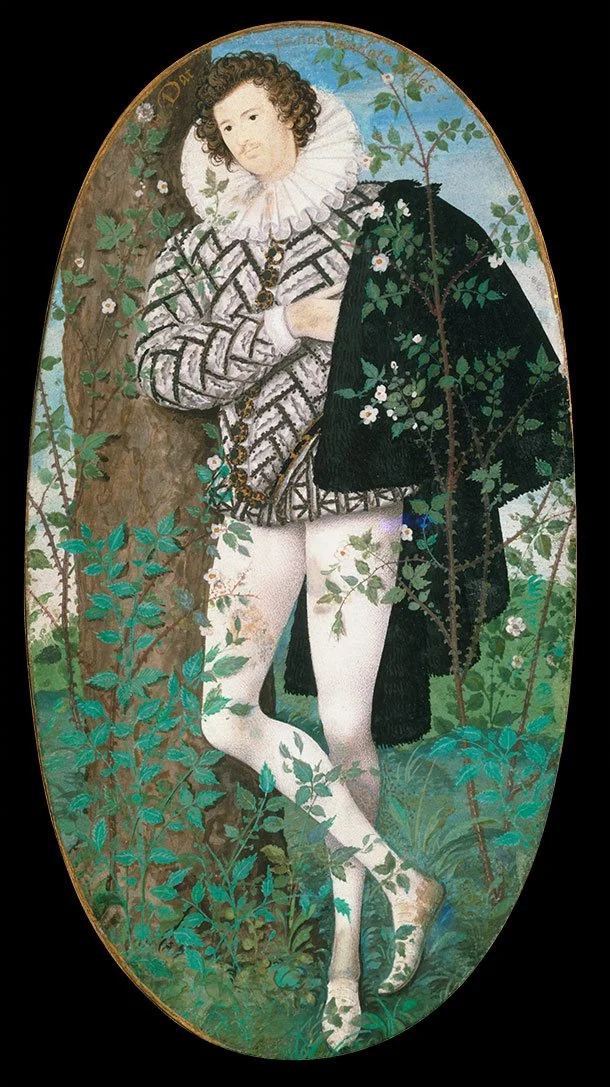‘To Plead My Faith’: Passionate Anguish and Courtly Love for Elizabeth I
⏵︎ “To plead my faith,” a sonnet written by Robert Devereux, Earl of Essex, captures his tumultuous relationship with Queen Elizabeth I. This poem, set to music by Daniel Batchelar, was published in Robert Dowland’s 1610 collection “A Musicall Banquet.” It bears the inscription: "The Right Honourable Robert, Earle of Essex: Earle Marshall of England. To Plead my faith where faith hath no reward." Its opening line echoes the Latin motto "Dat poenas laudata fides" ("Faith, though praised, brings penalties”) from the famous miniature "Young Man among Roses," often identified with Robert Devereux.
Portrait miniature A Young Man Among Roses, possibly Robert Deveraux, 2nd Earl of Essex (1566-1601), by Nicholas Hilliard, 1585-95.
Essex's court history, from his debut in 1584 to his execution, was characterized by ambition and the Queen's complex emotional and political maneuvers. Their relationship was marked by fierce quarrels and uneasy reconciliations. After disputes, Essex would often leave court, either waiting for the Queen to summon him back or actively working to regain her favor through letters and poetry. His poems, while appearing to be typical courtly love verses, contained specific references to Elizabeth, making them deeply personal. Two lines in particular highlight this: "I loved her whom all the world admir'd" — who was more admired than Elizabeth? — and "I was refused of her that can love none" — Ben Jonson stated that Elizabeth "had a membrana on her which made her uncapable of man." Another line, "I was as fond as ever she was fair, yet loved I not more then I now despair," echoes a sentiment from a letter Essex wrote to the Queen during one of his retreats at Wanstead: "I do carry the same heart I was wont, though now overcome with unkindness, as before I was conquered by beauty."
British Library, Add. MS 24665, f.48v.
The British Library Add. MS 24665, “Giles Earle's Book,” is a collection of songs compiled between 1615 and 1626 for treble voice with a bass line, presented on facing pages rather than in score. None of the composers are named, but the book is a treasure trove of arrangements by prominent lutenists of the day, including works by Dowland, Campion, Daniel Batchelar, and others. Many of the songs include written-out embellishments.
It contains a heavily embellished version of Batchelar's song. This manuscript features only treble and bass parts, while the 1610 version includes lute tablature accompaniment. Batchelar's song, originally written in galliard form, is rearranged in Earle's songbook in quadruple time, likely to allow for more ornamentation.



Taste in vocal embellishments and diminutions has changed over the decades, and Earle’s version of “To plead my faith” exemplifies a late sixteenth- and early seventeenth-century style of ornamentation. These divisions exhibit a wild, undisciplined virtuoso style, possibly the kind of "blind Division-making" criticized by John Dowland (“To the reader,” A Pilgrim’s Solace, 1612).
Despite potential criticism, Earle's divisions demonstrate a sophisticated rhythmic freedom. His divisions often exceed the original note values, making the notation of the rhythm often ambiguous. Like other performers, he frequently expanded the penultimate and/or antepenultimate notes of the original to accommodate elaborate cadential diminutions, occasionally applying this at phrase beginnings too. Earle's divisions were more musically than textually motivated, often ignoring traditional text underlay principles by placing divisions on unimportant words and unaccented syllables. This contrasts with theorists like Giovanni Battista Bovicelli, who emphasized careful word-note placement. Earle filled in leaps and strayed from the original melody, using climax and gradatio to intensify Batchelar's rising melody, techniques common in both English and Italian sources.
‘To plead my faith’ from Robert Dowland’s A Musicall Banquet, 1610.
The following comparative edition attempts to incorporate the divisions from Earle's songbook while retaining the original galliard form from Robert Dowland's 1610 collection. The embellished version appears on a small staff above the original setting. The bass line is transcribed from both Earle's and Dowland's versions, with small notes with downward stems representing Earle's bassline. Corrections are indicated by small notes above the staff showing the original note values, and editorial accidentals are enclosed in brackets.




Other contemporaneous manuscripts, such as Christ Church Library MS Mus 439 and 87, Fitzwilliam Museum MU.MS.782, and British Library Add. MS 29481, also exhibit similar rhythmic freedom in vocal ornamentation. These sources provide modern singers with various options for incorporating divisions, from mid-sixteenth-century cadential ornamentation to the flamboyant styles of the late sixteenth and early seventeenth centuries.
References:
Toft, R. (2014). With Passionate Voice: Re-Creative Singing in Sixteenth-Century England and Italy. United Kingdom: Oxford University Press.
Poulton, D. (1982). John Dowland. United States: University of California Press.
Strong, R. (1986). The Cult of Elizabeth: Elizabethan Portraiture and Pageantry. University of California Press.
Jones, E. H. (1989). The Performance of English Song: 1610-1670. United Kingdom: Garland Pub.
Marinčič, D. (2024). “‘Nach Seinem Selbst Gefallen Mit Der Mensur Wexln’: Instances in Sixteenth-Century Keyboard Music Where Ornamentation and Changing Note Values Might Induce the Player to Vary the Beat.” In ‘Universum Rei Harmonicae Concentum Absolvunt’. The Harpsichord in the Sixteenth Century, edited by Augusta Campagne and Markus Grassl. Wien: mdwPress.
Jorgens, E. B. (1986). English song 1600–1675: Facsimiles of twenty-six manuscripts and an edition of the texts. Garland.


